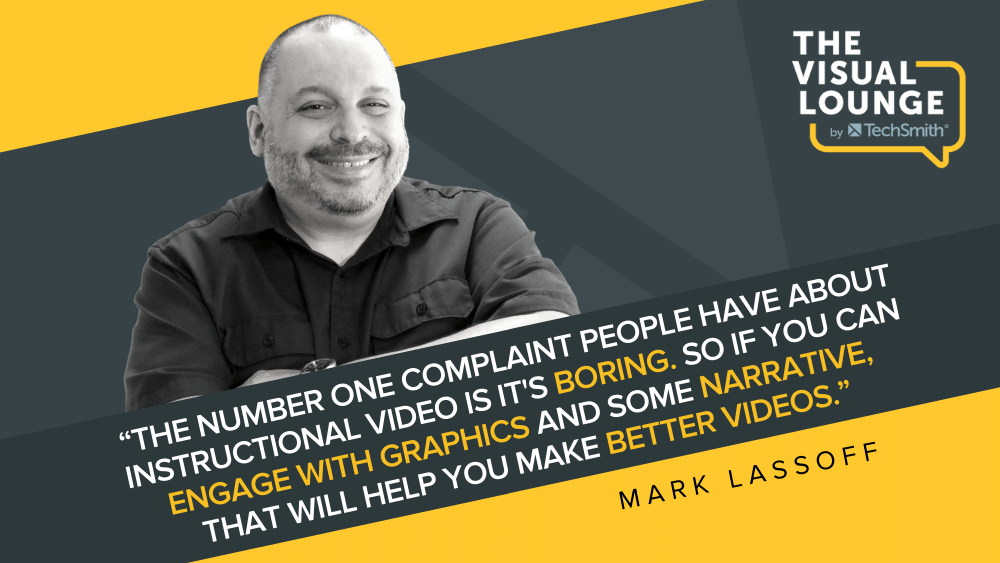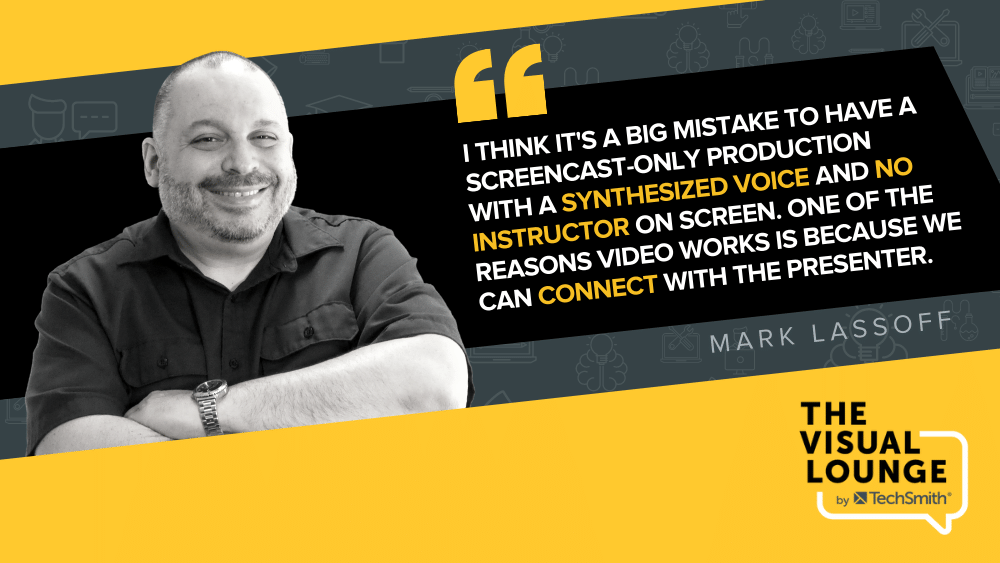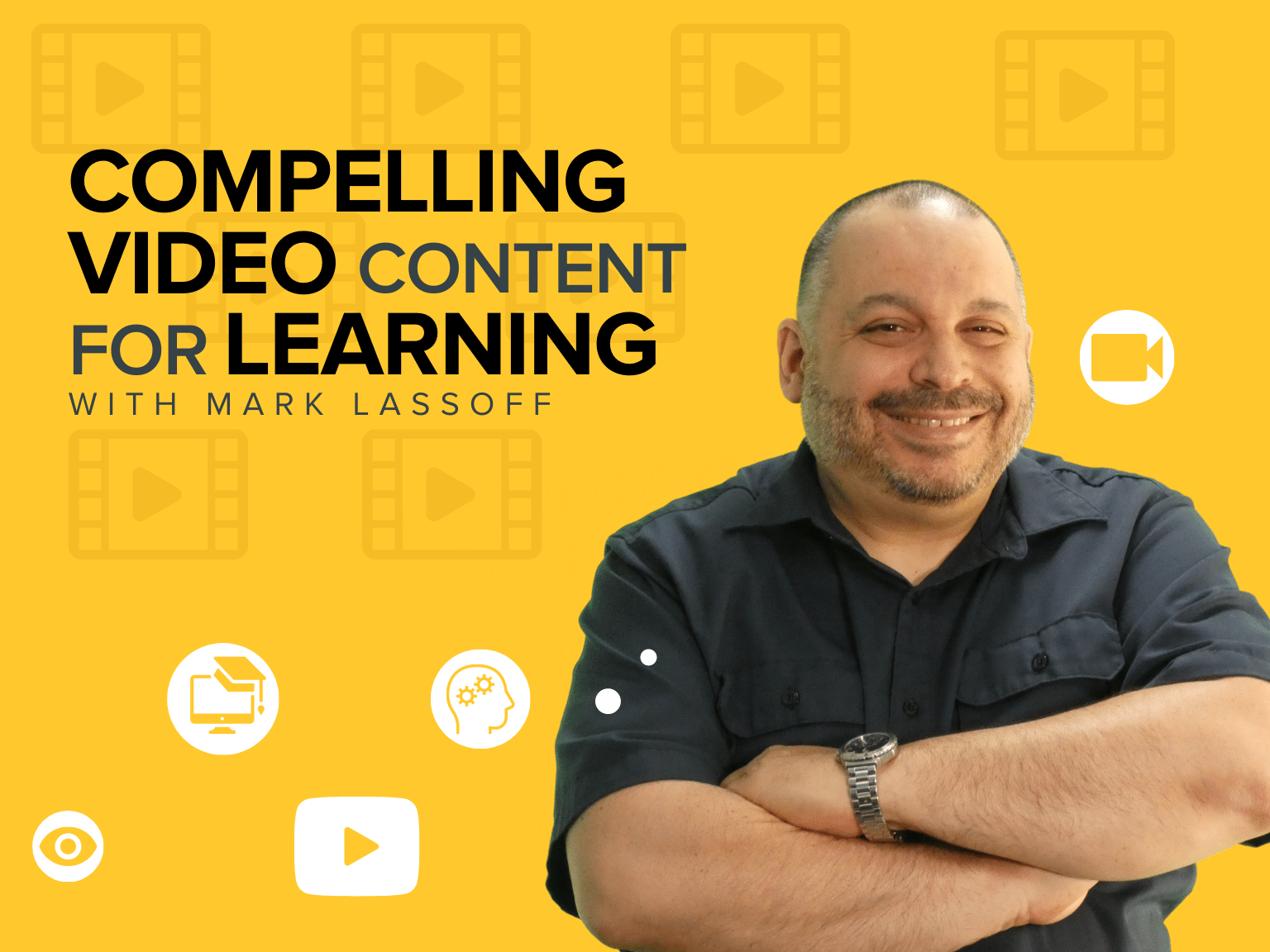When it comes to creating learning video content, the key to success is how engaging it is. A video can have all the right information and be clear and comprehensive, but it can fall flat with the viewer unless it’s compelling.
A compelling video keeps viewers engaged, meaning any message you want to convey is much more likely to stick.
But what’s the secret to creating compelling instructional videos?
Mark Lassoff, Video Instructor and Founder of Tech Learning Network, is on The Visual Lounge to share some words of wisdom on his process and advice for others. Mark breaks down the three must-have elements of any video and explains why talent and expensive cameras are overrated.
The Tech Learning Network produces broadcast-quality learning content that focuses on digital skills such as design, coding, and digital productivity.
Before launching the Tech Learning Network, Mark started several companies in Connecticut and Austin. He’s currently an in-demand speaker and has traveled the world sharing his wisdom. Mark has also authored eight books on programming and was awarded the prestigious Learning Guild Master Award in 2017.
You can watch the video on this topic at the top of this post, to listen to the podcast episode, hit play below, or read on for more…
A media-first approach
Mike has a slightly different approach to learning content than most people. Many instructional designers and video creators start with the educational aspect and build content around that like you would with school or training.
But Mark likes to take a media-first approach. His main aim is to build good media that’s compelling, interesting, and informed by educational theory.
“I’ve tried very hard to marry the idea of compelling media and educational content, to make something that I think is a little more watchable than typically what’s produced.”
Why does this approach work so well for Mark?
In his eyes, a common mistake people make is assuming that viewers are comparing their learning content to the last educational video or course they watched. In reality, viewers compare it to other media, like what they last watched on Netflix or YouTube.
In an ideal world, the teams producing learning content would be composed of instructional designers and media creators to get better results overall.
What makes a piece of content compelling?

Everyone reacts differently to content, true. Some might find a video enthralling. Others not so much.
But for the best chance of engaging your audience, your videos need to take three must-have elements into account.
1. Content style or format
Mark’s first tip is to match the content and style with the reason people are consuming it.
On the one hand, if people are looking for an immediate answer to a question, they’ll appreciate a short, straight-to-the-point video.
On the other hand, if people want to learn about spreadsheets, that content will need to be longer, multi-topical, and broken down into different videos.
You should learn more about your potential viewer to get this part right. Who are they? Why are they watching this? What’s their expectation after the video?
Learning more about the position your viewers are in when they watch your video will help you tailor the content and style to what they’re looking for.
2. It needs strong visuals and good production
The next important element is what the video looks like. It should have strong visuals that are compelling and don’t distract the viewer. You might want to use graphics to highlight a learning point or change camera angles to keep people engaged.
A common roadblock people face is the assumption that you need very expensive equipment or an entire studio to produce quality content.
In reality, Mark says it’s more about skill than equipment or natural talent. He breaks it down as the following.
Compelling video content requires:
- 90% skill
- 10% equipment or resources
- 0% talent
Anything you don’t know, you can learn. And when it comes to equipment, knowing the best ways of using it is far more important than the type of equipment.
You can make a high-quality video on a cell phone these days if you learn how to do it right. If you don’t learn the skills, even a $10,000 camera isn’t going to save your video.
“I don’t think it’s a matter of buying expensive equipment. I think you can start pretty low-end with what’s in your pocket. There have been entire feature films shot on iPhones.”
3. Introduce the idea of narrative
The narrative should be an essential feature of your content where the format allows it.
Everyone relates to a story. Even highly technical tutorials on YouTube use narrative to get their point across. The narrative also introduces “stickiness,” so viewers come back for more.
When working with narrative, you want to make sure “your narrative’s appropriate for your audience and the purpose of that particular video.”
If you can integrate stories into learning, people are more likely to remember the message, making the video much more compelling to watch.
The problem with using synthesized voices

A common learning video type is a screencast with a synthesized voiceover. This type of video is easier to produce in some ways, but Mark warns against using them.
Without a presenter and an authentic voice, these videos can be “dehumanizing” and create a disconnect between your video and the audience. It’s much harder to connect to a robotic voice talking through a screencast than watching a video with an engaging presenter.
“When we create videos, we always act as if only one person was watching. And we want to make that connection with them.”
Mark’s process for creating videos
Mark says that when he’s going to teach a piece of software, he starts by documenting every feature that will appear on the screen. Then, he and his team arrange that into an order that makes sense.
By the time it comes to shooting the video, it’s not just about that single video. He’s also thinking about shooting microlearning, course videos, and promotional videos. This approach lets him “get more bang for our buck” with each video.
During the shooting process, this is usually done with an instructor on screen to help focus people, even if it’s a screencast with a bunch of annotations. Once the shooting is done, the team will edit it for different formats and start sending it out there.
“One of the reasons we’ve been successful is the ability to multi-purpose video and shoot once and use it a number of different ways for different audiences.”
While the process is a bit more complex than this, Mark says, this is it in a nutshell, and it’s safe to say it’s been working pretty well for Tech Learning Network.
To learn more awesome tips for creating compelling instructional videos, be sure to check out TechSmith Academy and Mark’s Tech Learning Network YouTube channel.



Share